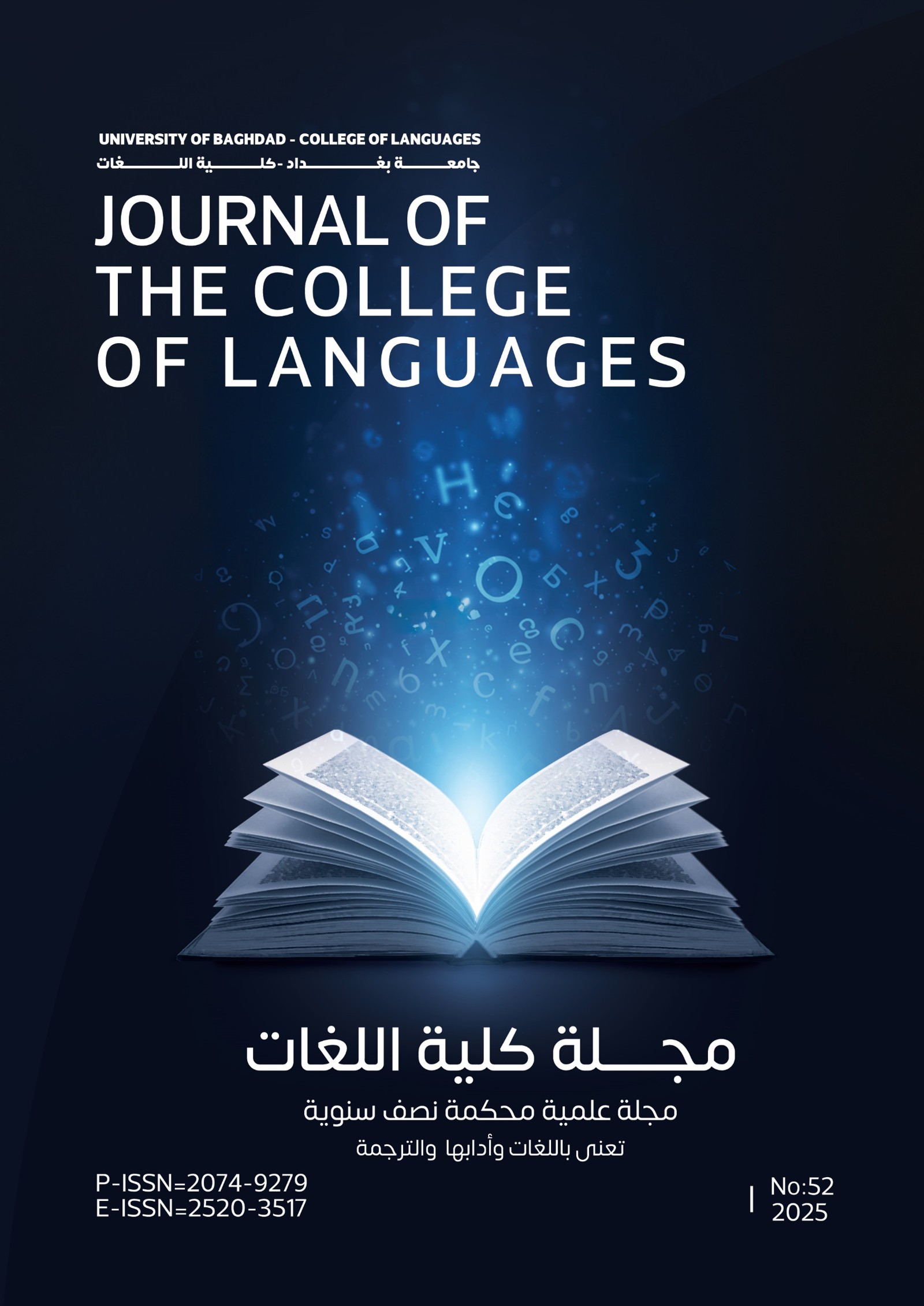An excerpt on the analysis of correlate constructions
Exkurs zur Analyse der Korrelat konstruktionen
DOI:
https://doi.org/10.36586/jcl.2.2024.0.49.0059Keywords:
Keywords: correlate-Maher Hony Habib, correlate construction-M. H. Hraishawi, analysis of correlates-Maher H. Habib, connectors and correlates in German-M. H. HraishawiAbstract
The main idea that led me to write such research paper within the framework of Germanic linguistics is that I have not found any topic dealing with the term correlate in the German language, except in several articles in linguistic journals as well as one topic in a book describing the use of such a linguistic phenomenon in the language system. The research initially deals with the definition of the correlate at the level of the German language system. Correlate is unity describes specific relation of two sentences and identifies denoted constructs. Correlate is called a placeholder at the syntactic level because it does not occupy its original topological fields in the syntactic structure. The correlate (es) or the prepositional adverbs or adverbs can occur in the matrix clause, it is the second feature. The third categorical feature of the correlate is morphological, in that the correlate is inflexible and the last feature shows that the correlate does not confer case features on its syntactic environment, where the correlate possesses the matrix clause. The correlate can appear as the first part of the complex connector in the subordinate clause or the infinitive construction. The last feature refers to the fact that the correlate construction can be attributive in the complex sentence, whereby the sentence structure, which is the constituent of attributively formed correlate specifiers, is embedded.
The research presents the conceptual content of the linguistic expression described by the correlate, functioning as a pro-element in the major premise and considered as a dentate. It is a matter of denotation of the correlate and deictic expressions. Furthermore, the present research sheds light on the obligatory and optional use of the correlate constructions in the German sentence. In German there are correlates when using certain verbs. In addition, certain linguistic constructions or expressions require correlates of both particles and prepositional adverbs. The reasons for this are contextual and communicative aspects.
In relation to the contextual-communicative aspects such as verbs affect the connection with the correlate. She signals the connection through the grade particles. Compared to other verbs, the use of the correlate (es) is reduced. The reason for this is the appearance of degree particles as well, even, at most, only, only. This can be the case if the grading of the text passage does not focus on the extreme predicate, but rather on the infinitive construction or the subordinate clause. This was studied at work.
Then it was examined how the correlate constructions occur with certain subjunctives by dividing them into two forms, namely attributive correlate constructions and left displacement constructions. If the correlate occurs before the subjunctive phrase, it is called an attributive correlate construction. This form is also called a correlate specifier. The subjunctive phrase has the function of being an attribute for the correlate. They can be directly followed by the correlate, whereby it is possible that the correlate alone carries the main clause after deducting the so-called phrase.
Zusammenfassung
Die Hauptidee besteht darin, wie sich das Phänomen Korrelat im deutschen Sprachsystem anwenden lassen. Solche Forshchungsarbeit verortert sich im Rahmen der germanistischen Sprachwissenschaft. Da Sprachstudien – über ihre linguistische Relevanz hinaus – auch den Lernenden nützliches empirisches bzw. didaktisches Material zur Wortschatzerweiterung einen Überblick erarbeitet, spielt doch die linguistische Forschungsarbeit eine große Rolle bei der Verbesserung der Sprachkompetenz und der Syntaxverfahren. Diese Arbeit beschäftigt sich mit Korrelatkonstruktionen im Deutschen. Es geht um die Konnektstellungsmöglichkeiten und topologische Felder der relevanten sprachlichen Ausdrücke in dem deutschen Text. Der Ausgangspunkt ist dezidiert die deutsche Sprache. Anhand der vorliegenden Arbeit werden die Fragen gestellt, ob es kategoriale Merkmale für die Korrelatestellung gibt oder welche spachsystematischen Voraussetzungen die Anwendung des Korrelates bestimmen. Des Weiteren wird in dieser Arbeit beleuchtet, was der Grund dafür ist, dass das es als Korrelat genannt wird. Das grammatikalische es, bestimmte Adverbien wie sogar, nur und die Partikel wie auch gehören zu den unterschiedlichen Subklassen der Wortarten. Die deutschen Grammatiken gehen darin in ihren Publikationen nicht ein. Die vorliegende Forschung untersucht diese Problematik.
Die Forschung untersucht den begrifflichen Inhalt des sprachlichen Ausdrucks, den das Korrelat beschreibt, wobei es im Obersatz als Pro-Element fungiert und als Denotat betrachtet wird. Es handelt sich um Denotat des Korrelats und deiktische Ausdrücke. Des Weiteren beleuchtet die vorliegende Forschung obligatorischen und fakultativen Gebrauch der Korrelatkonstruktionen in dem deutschen Satz. Im Deutschen stehen Korrelate bei der Verwendung bestimmter Verben. Daneben fordern bestimmte sprachliche Konstruktionen bzw. Ausdrücke Korrelate sowohl Partikeln als auch Präpositionaladverbien. Die Gründe dafür sind kontextuelle sowie kommunikative Aspekte.
Received on 10/1/2023
Accepted on 20/8/2023
Published on 2/1/2024)
References
Bausweise, Karin. (1990). Accusative object, accusative object sentences and object predicates in German: Studies on their syntax and semantics (Linguistic Works, Volume 251). Tübingen: de Gruyter Verlag.
Breindle, Eva. (1989). Prepositional objects and prepositional object sentences in German. Tübingen: Niemeyer Verlag.
Engel/Ulrich. (1996). Deutsche Grammatik. Heidelberg: Groos Verlag.
Engel, Ulrich & Schumacher, Helmut. (1976). Little valence lexicon of German verbs. IDS. Tübingen: Narr Verlag.
Helbig, Gerhard & Buscha, Joachim. (1991). German grammar. In Handbook for Teaching Foreigners. 13. Aufl. Leibzig u. a.
Sonnenberg, Bernhard. (1992). Correlates in German: description, history and theory of grammar. Tübingen: Niemeyer Verlag.
Mollica, Fabio. (2007). Korrelate in German and Italian. Band 9. Frankfurt am Main [u.a.]: Peter Lang Verlag.
Pasch, Renate, Brauße, Ursula, Breindl, Eva, Waßner & Ulrich, Hermann. (2003). Handbook of German connectors: linguistic basics of description and syntactic features of German sentence linkers (conjunctions, sentence adverbs and particles). In: Eroms, Hans-Werner/Stickel, Gerhard/Zifonun, Gisela (Hrsg.): Schriften des Instituts für Deutsche Sprache. Berlin [u.a.]: de Gruyter Verlag.
Sonnenberg, Bernhard. (1992). Correlates in German. Description, history and theory of grammar. Tübingen Verlag.
Winkel, Edeltraud. (1990). Satzeinbettung mit Hilfe von Korrelaten (am Beispiel der verba decendi im Deutschen. In: Bahner, Werner/Schildt, Joachim/Viehweger, Dieter (Hg.): Proceedings of the Fourteenth International Congress of Linguists. Berlin/GDR, August 10-August 15, 1987. Berlin. S. 1126.
Zifonun, Gisela, Hoffman, Ludger, Strecker, Bruno, Ballweg, Joachim, Brauße, Ursula, Breindl, Eva, Engel, Ulrich, Frosch, Helmut, Hoberg, Ursula & Vorderwülbecke, Klaus. (1997). Grammar of the German language. volume 2. Berlin [u.a.]: Walter de Gruyter Verlag.
Zimmermann, Ils. (1993). On the syntax and semantics of sentence embedding. In: Rosengren, Inger (Hrg.): Satz und Illokution. Bd. 2. (= Ars Linguistica 9). Tübingen.
Downloads
Published
Issue
Section
License
Copyright (c) 2024 Journal of the College of Languages (JCL)

This work is licensed under a Creative Commons Attribution 4.0 International License.








